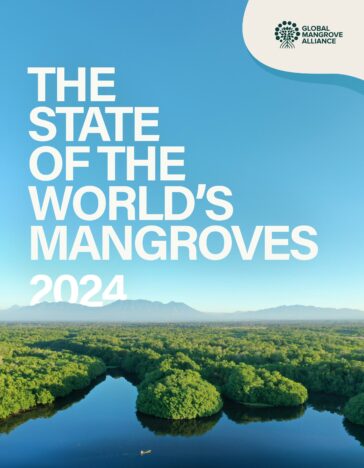
New State of the World’s Mangroves Report 2024 underscores critical linkages to biodiversity, climate, and communities
-
Climate and disaster risks
-
Coastal resilience
-
Coastal wetland conservation
-
Coasts & Deltas
A new report released today on World Mangrove Day highlights efforts to protect and restore these important ecosystems, which billions of people depend on for food, protection, and their livelihoods.
Produced by the Global Mangrove Alliance (GMA), a coalition of more than 100 government and non-government organisations including IUCN, the State of the World’s Mangroves 2024 report provides a comprehensive assessment of the latest scientific advancements and policy efforts to protect these valuable ecosystems. It also features more than 60 case studies and examples of field-based research that are contributing to national and global biodiversity and climate goals.
“Under the Convention on Biological Diversity, the global community has recognized the importance of biodiversity, not only for its own sake but also for the many ecosystem services and functions it provides for our well-being and survival,” said Ms Astrid Schomaker, the Executive Secretary of the Convention. “In many ways, mangroves are the poster child of the interdependence between people and nature.”
Ms Astrid Schomaker, the Executive Secretary of the Convention
Mangrove ecosystems are an important indicator of biodiversity health, and critical for climate mitigation and adaptation. However, a first-of-its-kind global assessment published in May by IUCN’s Red List of Ecosystems shows that half of all mangrove ecosystems are at risk of collapse by 2050 due to climate change.
The GMA report highlights how land-based conversion activities are also having an impact. A recent FAO study found that conversion to aquaculture, oil palm plantations, and rice cultivation combined account for up to 43% of mangrove losses between 2000 and 2020.
The loss of mangrove ecosystems can have wide-ranging impacts, according to experts.
Quote from editors or individual institutions can customise and add their own quote:
“Through their multitude of benefits, mangroves sustain and safeguard entire communities,” writes Maricé Leal and Mark Spalding, both with The Nature Conservancy (TNC). “Mangroves are critical to our response to climate change, both in mitigating change through carbon storage and sequestration, and through more local benefits – by helping us adapt to the change we are already too late to avoid.”
“We’ve seen the global community increasingly recognise the importance of mangroves, our roots of hope,” said Minna Epps, IUCN Global Ocean Director. “But at this crucial moment, much more investment in our blue natural capital and coordination is needed. Now is the moment to act. No single person or organisation can do it alone, we need all hands on deck to achieve the ambitious global targets”.
According to the report, new data and better mapping are helping identify and inform decision-makers responsible for setting policies to protect these valuable ecosystems. Global Mangrove Watch, for example, has confirmed a sixfold improvement in its ability to map mangroves, adding six new territories to their database.
The Mangrove Breakthrough, a global campaign launched in late 2022 to restore and protect mangrove ecosystems, has placed mangroves centre stage, gaining support from 50 governments with a goal of mobilising USD 4 billion to ensure the future of 15 million hectares of mangroves. These efforts will contribute to the Kunming-Montreal Global Biodiversity Framework, the Paris Agreement and Sustainable Development Goals on climate, oceans and more.
Southeast Asia has almost 50,000 km2 of mangrove cover, or about one-third of all mangroves globally. (Indonesia alone has 21% of the world’s mangroves.) This region is followed by West and Central Africa and then the Americas.
The GMA is coordinated by Conservation International, IUCN, The Nature Conservancy, Wetlands International, and the World Wildlife Fund, as well as Audubon Americas representing the GMA National Chapters and the South Asia Consortium for Interdisciplinary Water Resources Studies (SaciWATERs) representing GMA members.
The GMA is also currently conducting the 2024 Impact Stock Take to measure worldwide progress towards 2030 Goals to halt loss, restore half of degraded mangrove forests, and increase protection of mangroves and identify and connect viable projects with funding and training opportunities. Anyone working on mangrove projects, policy, research, or diversified livelihood projects in mangrove ecosystems is warmly welcome to fill out the survey by 31 August 2024 here.
Or visit the GMA website
Download the Report here.

